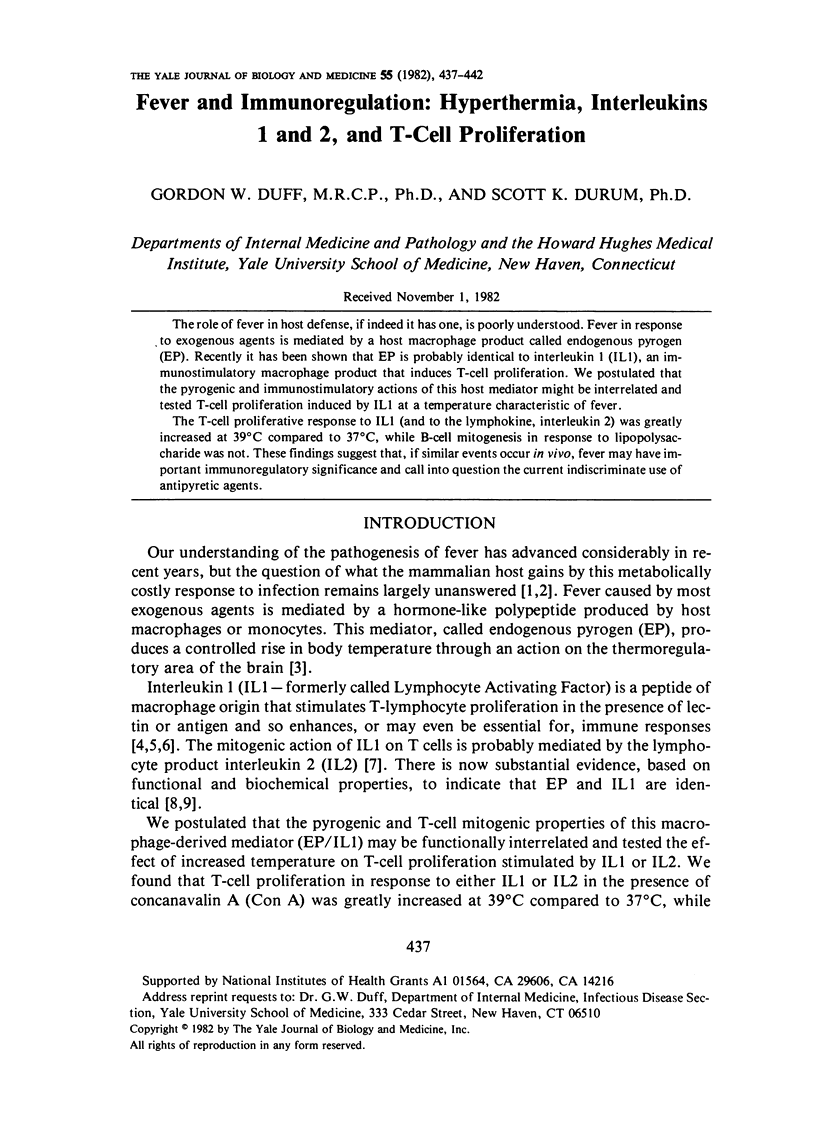Abstract
The role of fever in host defense, if indeed it has one, is poorly understood. Fever in response to exogenous agents is mediated by a host macrophage product called endogenous pyrogen (EP). Recently it has been shown that EP is probably identical to interleukin 1 (IL1), an immunostimulatory macrophage product that induces T-cell proliferation. We postulated that the pyrogenic and immunostimulatory actions of this host mediator might be interrelated and tested T-cell proliferation induced by IL1 at a temperature characteristic of fever. The T-cell proliferative response to IL1 (and to the lymphokine, interleukin 2) was greatly increased at 39 degrees C compared to 37 degrees C, while B-cell mitogenesis in response to lipopolysaccharide was not. These findings suggest that, if similar events occur in vivo, fever may have important immunoregulatory significance and call into question the current indiscriminate use of antipyretic agents.
Full text
PDF





Selected References
These references are in PubMed. This may not be the complete list of references from this article.
- Ashman R. B., Nahmias A. J. Enhancement of human lymphocyte responses to phytomitogens in vitro by incubation at elevated temperatures. Clin Exp Immunol. 1977 Sep;29(3):464–467. [PMC free article] [PubMed] [Google Scholar]
- Atkins E. Fever: its history, cause, and function. Yale J Biol Med. 1982 May-Aug;55(3-4):283–289. [PMC free article] [PubMed] [Google Scholar]
- Bernheim H. A., Block L. H., Atkins E. Fever: pathogenesis, pathophysiology, and purpose. Ann Intern Med. 1979 Aug;91(2):261–270. doi: 10.7326/0003-4819-91-2-261. [DOI] [PubMed] [Google Scholar]
- Bernheim H. A., Bodel P. T., Askenase P. W., Atkins E. Effects of fever on host defense mechanisms after infection in the lizard Dipsosaurus dorsalis. Br J Exp Pathol. 1978 Feb;59(1):76–84. [PMC free article] [PubMed] [Google Scholar]
- Bodel P., Miller H. Pyrogen from mouse macrophages causes fever in mice. Proc Soc Exp Biol Med. 1976 Jan;151(1):93–96. doi: 10.3181/00379727-151-39150. [DOI] [PubMed] [Google Scholar]
- Cranston W. I., Hellon R. F., Townsend Y. Suppression of fever in rabbits by a protein synthesis inhibitor, anisomycin. J Physiol. 1980 Aug;305:337–344. doi: 10.1113/jphysiol.1980.sp013367. [DOI] [PMC free article] [PubMed] [Google Scholar]
- Durum S. K., Gershon R. K. Interleukin 1 can replace the requirement for I-A-positive cells in the proliferation of antigen-primed T cells. Proc Natl Acad Sci U S A. 1982 Aug;79(15):4747–4750. doi: 10.1073/pnas.79.15.4747. [DOI] [PMC free article] [PubMed] [Google Scholar]
- Gery I., Gershon R. K., Waksman B. H. Potentiation of cultured mouse thymocyte responses by factors released by peripheral leucocytes. J Immunol. 1971 Dec;107(6):1778–1780. [PubMed] [Google Scholar]
- Harwell L., Skidmore B., Marrack P., Kappler J. Concanavalin A-inducible, interleukin-2-producing T cell hybridoma. J Exp Med. 1980 Oct 1;152(4):893–904. doi: 10.1084/jem.152.4.893. [DOI] [PMC free article] [PubMed] [Google Scholar]
- Kluger M. J., Ringler D. H., Anver M. R. Fever and survival. Science. 1975 Apr 11;188(4184):166–168. [PubMed] [Google Scholar]
- Kluger M. J., Vaughn L. K. Fever and survival in rabbits infected with Pasteurella multocida. J Physiol. 1978 Sep;282:243–251. doi: 10.1113/jphysiol.1978.sp012460. [DOI] [PMC free article] [PubMed] [Google Scholar]
- Lachman L. B., Hacker M. P., Blyden G. T., Handschumacher R. E. Preparation of lymphocyte-activating factor from continuous murine macrophage cell lines. Cell Immunol. 1977 Dec;34(2):416–419. doi: 10.1016/0008-8749(77)90263-5. [DOI] [PubMed] [Google Scholar]
- Larsson E. L., Iscove N. N., Coutinho A. Two distinct factors are required for induction of T-cell growth. Nature. 1980 Feb 14;283(5748):664–666. doi: 10.1038/283664a0. [DOI] [PubMed] [Google Scholar]
- Leibson H. J., Marrack P., Kappler J. W. B cell helper factors. I. Requirement for both interleukin 2 and another 40,000 mol wt factor. J Exp Med. 1981 Nov 1;154(5):1681–1693. doi: 10.1084/jem.154.5.1681. [DOI] [PMC free article] [PubMed] [Google Scholar]
- Mizel S. B. Studies on the purification and structure-functional relationships of murine lymphocyte activating factor (Interleukin 1). Mol Immunol. 1980 May;17(5):571–577. doi: 10.1016/0161-5890(80)90155-8. [DOI] [PubMed] [Google Scholar]
- Murphy P. A., Simon P. L., Willoughby W. F. Endogenous pyrogens made by rabbit peritoneal exudate cells are identical with lymphocyte-activating factors made by rabbit alveolar macrophages. J Immunol. 1980 May;124(5):2498–2501. [PubMed] [Google Scholar]
- Roberts N. J., Jr, Steigbigel R. T. Effect of in vitro virus infection on response of human monocytes and lymphocytes to mitogen stimulation. J Immunol. 1978 Sep;121(3):1052–1058. [PubMed] [Google Scholar]
- Roberts N. J., Jr Temperature and host defense. Microbiol Rev. 1979 Jun;43(2):241–259. doi: 10.1128/mr.43.2.241-259.1979. [DOI] [PMC free article] [PubMed] [Google Scholar]
- Rosenwasser L. J., Dinarello C. A., Rosenthal A. S. Adherent cell function in murine T-lymphocyte antigen recognition. IV. Enhancement of murine T-cell antigen recognition by human leukocytic pyrogen. J Exp Med. 1979 Sep 19;150(3):709–714. doi: 10.1084/jem.150.3.709. [DOI] [PMC free article] [PubMed] [Google Scholar]
- Smith J. B., Knowlton R. P., Agarwal S. S. Human lymphocyte responses are enhanced by culture at 40 degrees C. J Immunol. 1978 Aug;121(2):691–694. [PubMed] [Google Scholar]
- Smith K. A., Lachman L. B., Oppenheim J. J., Favata M. F. The functional relationship of the interleukins. J Exp Med. 1980 Jun 1;151(6):1551–1556. doi: 10.1084/jem.151.6.1551. [DOI] [PMC free article] [PubMed] [Google Scholar]


